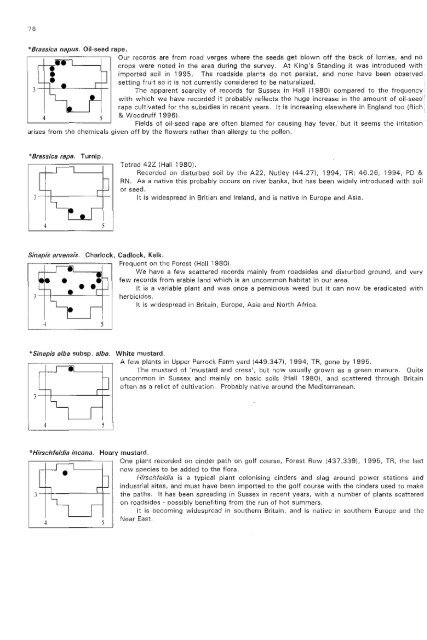Flora of Ashdown Forest - Botanical Society of the British Isles
Flora of Ashdown Forest - Botanical Society of the British Isles
Flora of Ashdown Forest - Botanical Society of the British Isles
You also want an ePaper? Increase the reach of your titles
YUMPU automatically turns print PDFs into web optimized ePapers that Google loves.
78*Brassica napus. Oil-seed rape.Our records are from road verges where <strong>the</strong> seeds get blown <strong>of</strong>f <strong>the</strong> back <strong>of</strong> lorries, and nocrops were noted in <strong>the</strong> area during <strong>the</strong> survey. At King's Standing it was introduced withimported soil in 1995. The roadside plants do not persist, and none have been observedsetting fruit so it is not currently considered to be naturalized.3-+~~~------Lf- The apparent scarcity <strong>of</strong> records for Sussex in Hall (1980) compared to <strong>the</strong> frequencywith which we have recorded it probably reflects <strong>the</strong> huge increase in <strong>the</strong> amount <strong>of</strong> oil-seed!rape cultivated for <strong>the</strong> subsidies in recent years. It is increasing elsewhere in England too {Rich;4 5& Woodruff 19961.Fields <strong>of</strong> oil-seed rape are <strong>of</strong>ten blamed for causing hay fever I but it seems <strong>the</strong> irritationarises from <strong>the</strong> chemicals given <strong>of</strong>f by <strong>the</strong> flowers ra<strong>the</strong>r than allergy to <strong>the</strong> pollen.*Brassica rapa. Turnip.~-+~ ________ -L+-Tetrad 42Z IHall 19801.Recorded on disturbed soil by <strong>the</strong> A22, Nutley 144.271, 1994, TR; 46.26, 1994, PD &RN. As a native this probably occurs on river banks, but has been widely introduced with soilor seed.It is widespread in Britian and Ireland, and is native in Europe and Asia.4 5Sinapis arvensis. Charlock, Cadlock, Kelk.Frequent on <strong>the</strong> <strong>Forest</strong> IHall 19801.We have a few scattered records mainly from roadsides and disturbed ground, and veryfew records from arable land which 'IS an uncommon habitat in our area.It is a variable plant and was once a perniciOUS weed but it can now be eradicated with3 -+-t---""---~'-t- herbicides.It is widespread in Britain, Europe, Asia and North Africa.*Sinapis alba subsp. alba. White mustard.A few plants in Upper Parrock Farm yard 1449.3471, 1994, TR, gone by 1995.The mustard <strong>of</strong> 'mustard and cress', but now usually grown as a green manure. Quiteuncommon in Sussex and mainly on basic soils (Hall 1980), and scattered through Britain<strong>of</strong>ten as a relict <strong>of</strong> cultivation. Probably native around <strong>the</strong> Mediterranean._, -++------'--1-4 5*Hirschfeldia incana. Hoary mustard.One plant recorded on cinder path on golf course, <strong>Forest</strong> Row (437.339), 1995, TR, <strong>the</strong> lastnew species to be added to <strong>the</strong> flora.Hirschfeldia is a typical plant colonising cinders and slag around power stations andindustrial sites, and must have been imported to <strong>the</strong> golf course with <strong>the</strong> cinders used to make3-i-r---------~-- <strong>the</strong> paths. It has been spreading in Sussex in recent years, with a number <strong>of</strong> plants scattered4 5on roadsides - possibly benefiting from <strong>the</strong> run <strong>of</strong> hot summers.It is becoming widespread in sou<strong>the</strong>rn Britain, and is native in sou<strong>the</strong>rn Europe and <strong>the</strong>Near East.
















